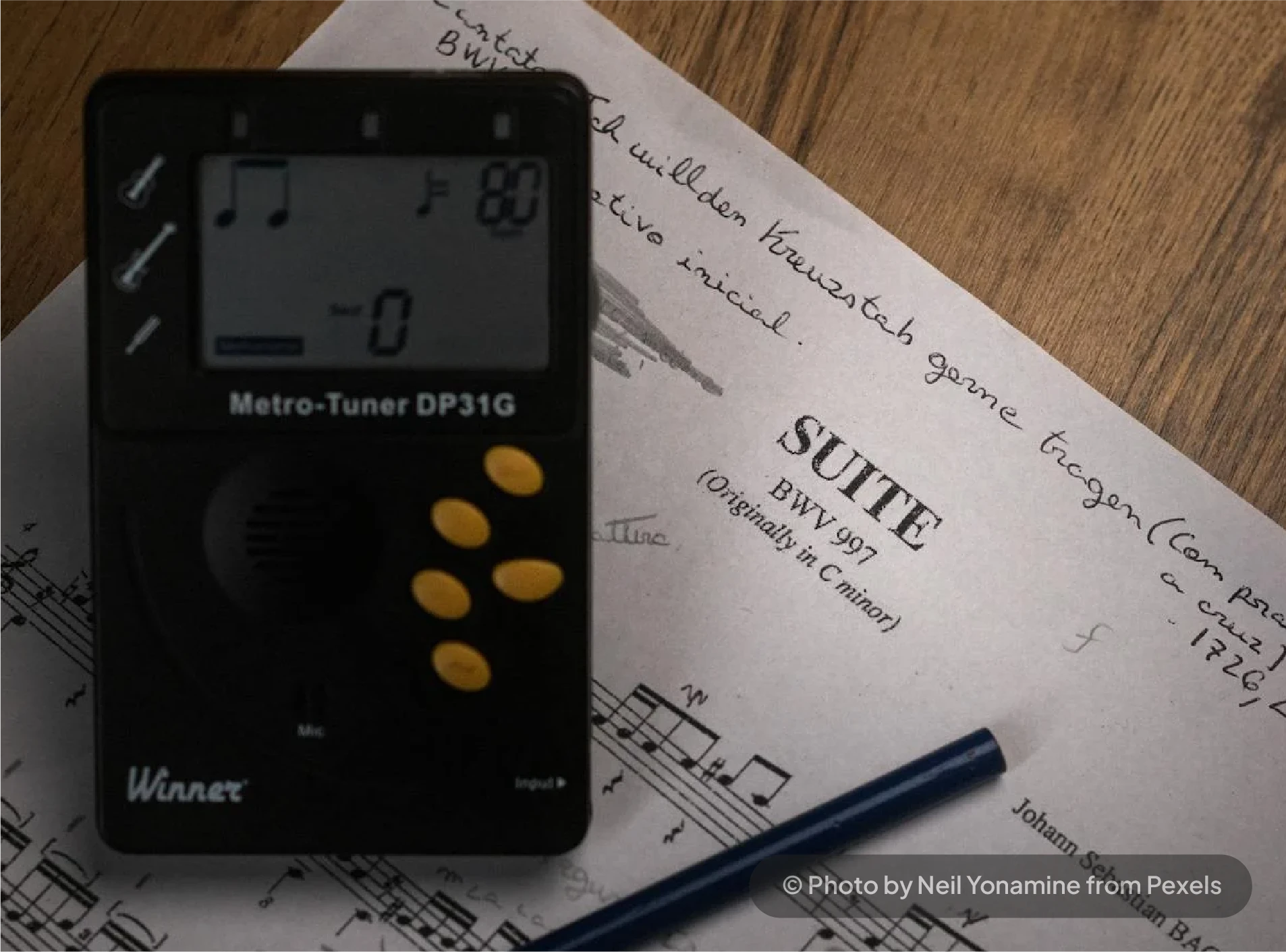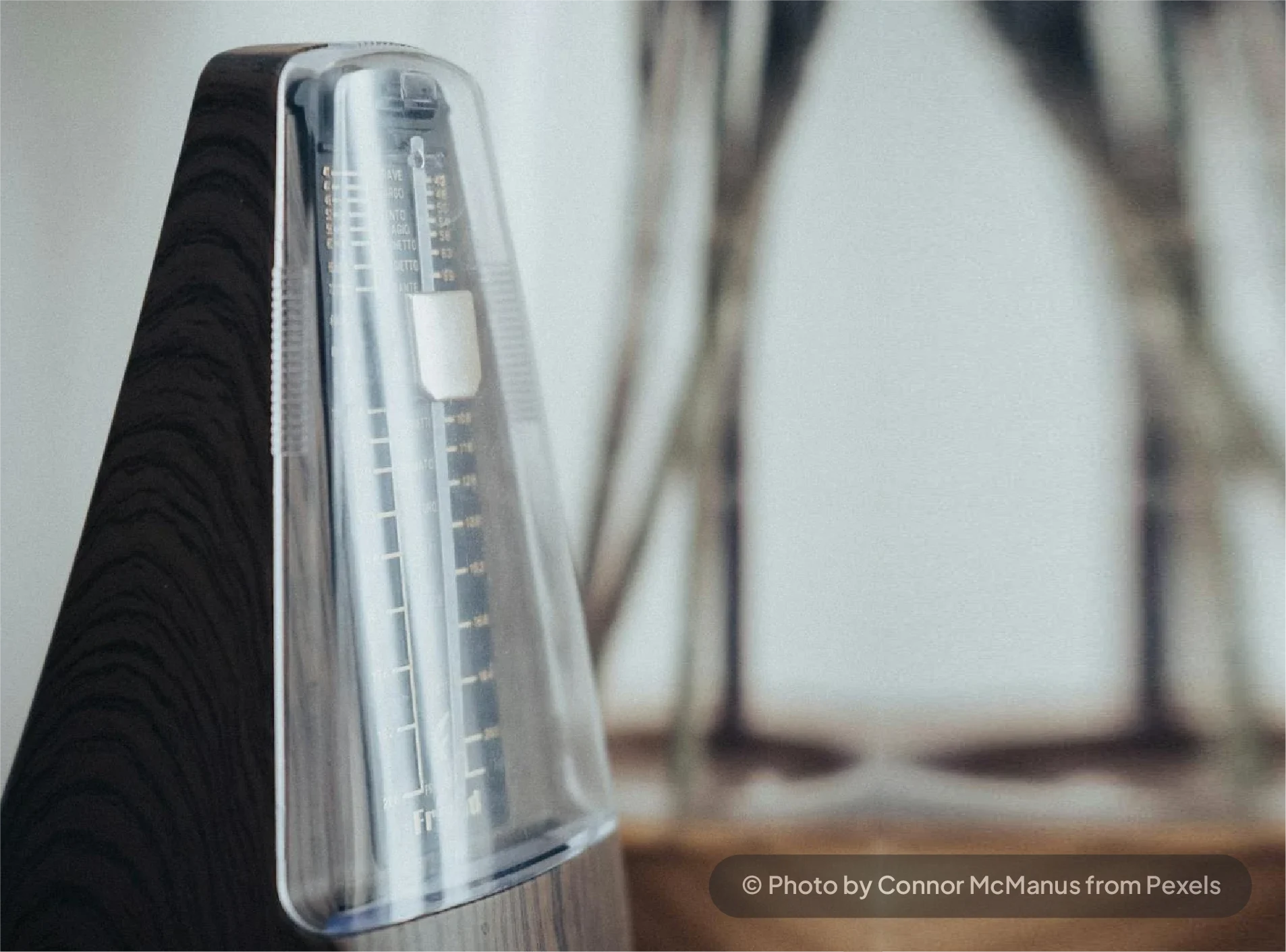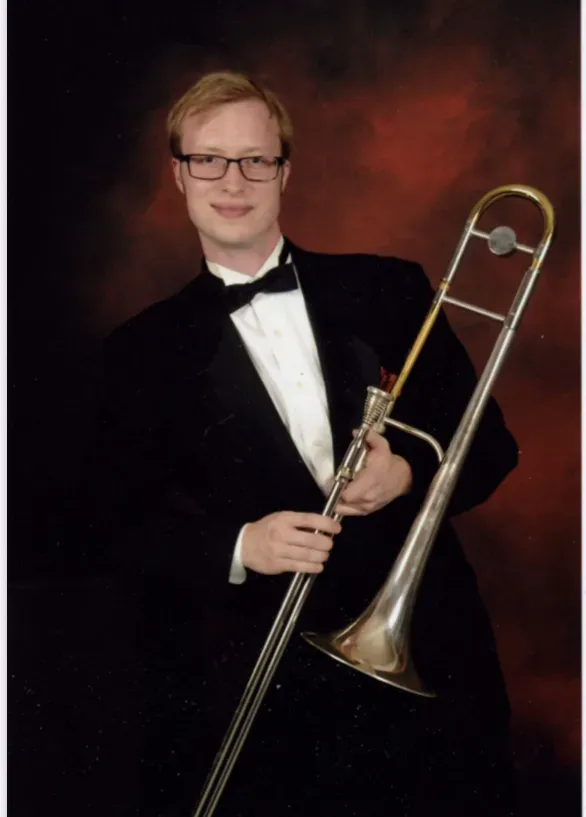What is a Metronome in Music? How to Use Metronome
In the world of music, where timing decides the difference between a captivating performance and a disorganized soundscape, the metronome has silently maintained its place as a vital tool.
The metronome, often neglected by beginners but fully recognized with experience, functions as a quiet mentor, keeping time, enforcing rhythm, and enhancing tempo control. But what is a metronome exactly? And the most crucial question is: how is a metronome used?
Let’s get into that.
What is a Metronome in Music?
At its core, a metronome is a device that produces regular, metrical ticks (also called beats or clicks) set to a specific tempo in beats per minute (BPM). These ticks act as a timing reference for musicians, enabling them to play or practice at a steady pace.
However, addressing the question "What is a metronome?" in one paragraph does not adequately convey its historical and musical significance.
The earliest known metronome design dates back to the early nineteenth century, when German inventor Johann Maelzel developed a mechanical version using a pendulum system. Even Beethoven, the great composer, embraced it, going so far as to include metronome markings on his scores- an uncommon move at the time.
Metronomes are now available in a variety of forms, including traditional wind-up mechanical devices with a swinging pendulum, digital tabletop models, and, more recently, sophisticated smartphone apps. Regardless of the format, the goal remains the same: to develop an accurate sense of time.
What are the Functions of a Metronome?
Now that we've defined a metronome, let's look more closely at its applications. From beginners learning their scales to virtuosos practicing concertos, the metronome serves many purposes:
- Tempo Training: One of the most common uses of a metronome is to maintain a consistent tempo throughout practice.
- Skill Development: A metronome can help you improve your rhythm. If a player repeatedly misses the beat, it indicates that there is room for improvement.
- Slow Practice: Playing a difficult section slowly and precisely is often more useful than rapid, impulsive repetition. A metronome helps with this by allowing the player to start slowly and progressively increase the tempo.
- Timing Synchronization: In ensemble settings, everyone practicing with a metronome facilitates tighter coordination, minimizing tempo-related disparities.
- Improving Internal Pulse: Regular metronome practice teaches a musician's internal pulse, allowing them to maintain a firm sense of timing even when they are not using one.
How is a Metronome Used in Music?
We now understand what a metronome is, but what is a metronome in music? To a non-musician, a metronome can seem to be nothing more than a fancy ticking clock. But for a musician, it is a key component of rhythmic discipline.
A metronome helps musicians improve their timing precision, consistency throughout practice sessions, and ability to stay in rhythm with others during group performances.

Think about learning a complex piano composition with rapid tempo changes. Practicing using a metronome lets you divide the composition into small sections, begin slowly, and gradually raise your speed. This planned method prevents speeding through difficult portions or dragging during easier ones.
The metronome is especially important in genres where rhythm is key, such as jazz, hip-hop, EDM, and Indian classical percussion. It sharpens a musician's internal clock, allowing them to lock into grooves, cycles, and rhythmic patterns with ease.
To improve your musical abilities, take offline or online music lessons where you will be taught more about the role of metronome.
Learn How to Use a Metronome in 6 Steps
Understanding how to use a metronome is essential for harnessing its potential. While it may appear as simple as turning it on and playing along, there is a method to this practice that can help you improve your musical ability.

1. Start by Setting the Tempo
Most digital and mechanical metronomes have a dial, slider, or input pad for adjusting the tempo. Tempo is measured in BPM (beats per minute). For example, 60 BPM is one beat per second.
- Beginners can focus on accuracy and rhythm by starting off slowly, perhaps at 60 beats per minute.
- Intermediate musicians can increase speed by setting the pace slightly faster than their comfort zone.
- Advanced users may master dynamic tunes by using varying tempos.
2. Select the Time Signature
Modern metronomes generally allow you to set time signatures (such as 4/4, 3/4, and 6/8). The metronome will then provide accented beats for each measure, allowing you to better grasp musical phrases. For example, in 4/4 time, the first beat will be louder, followed by three softer ones.
3. Practice Subdivisions
One effective strategy is to practice subdivisions. This involves setting the metronome to click on eighth, triplet, or sixteenth notes, depending on your composition. This is especially helpful when working with complex rhythms or syncopated portions.
4. Silent Practice with Intermittent Beats
Advanced players frequently practice by setting the metronome to click every few beats rather than every beat. For example, setting it to click every four beats analyzes the player's ability to maintain internal rhythm between clicks. This is a real tempo mastery test.
5. Raise the Tempo Incrementally
When learning a fast composition, begin slowly and progressively increase the BPM in minimal increments until you master each speed. This guarantees that muscle memory is formed appropriately and without ingraining errors.
6. Use Visual Aids (optional)
Many digital metronomes and applications provide visual cues like flashing lights and pendulum animations. These might be very useful for visual learners or in silent practice settings.
Why is it Important to Use a Metronome to Practice Slowly?
Practicing slowly with a metronome might seem like a small step, but it plays a huge role in shaping your musical foundation. It’s one of the most effective ways to develop control, precision, and a solid sense of timing—all of which are essential, whether you’re a beginner or an advanced musician.
Building a Strong Sense of Timing
One of the biggest advantages is that it helps you develop a strong sense of timing and rhythm. Playing along with a steady beat trains you to internalize the tempo, so you're not unconsciously speeding up or slowing down, especially during challenging sections. This becomes even more important when you’re playing with others or recording with a click track, where staying in sync is everything.
Creating Space to Notice Details
Slowing things down also gives you space to really pay attention to what’s going on. With each note, you can focus on finger placement, breath or bow control, and overall accuracy. A metronome keeps you honest—there’s no hiding behind tempo fluctuations.
This kind of focused practice makes it easier to notice mistakes or inconsistencies. Maybe a certain passage feels awkward, or your rhythm is off in one spot. Practicing slowly helps bring those issues to light so you can work through them before they become habits.
Strengthening Muscle Memory
Another important benefit is the way it helps build muscle memory. When you practice slowly, your body has time to learn each movement correctly. You’re not rushing through, so your brain and hands can fully absorb the mechanics of what you’re doing. And once you’ve got it down at a slow tempo, you can gradually increase the speed using the metronome, building confidence and control without losing clarity.
Getting Ready to Play with Others
This approach also prepares you for real-world scenarios—like playing with a band, in an ensemble, or in the studio. Developing a solid internal sense of rhythm makes it easier to stay in time with others and handle performance pressure. And once the technical side is handled, you’re free to focus on the music itself—phrasing, dynamics, emotion. That’s where true expression begins.
Precision and Musicality
In the end, slow practice with a metronome isn’t about holding you back—it’s about setting you up for success. It lays the groundwork for everything else, helping you play with more accuracy, confidence, and musicality. Think of it as building strength and coordination at the gym before running a race. It might take time, but the payoff is absolutely worth it.
Metronome as Your Musical Companion
Using a metronome does not have to be tedious. In fact, creative musicians use it in a surprising variety of ways. Percussionists use it to get into tight grooves. Guitarists could program drum loops with certain BPMs. Even famous Indian classical musicians and vocalists use digital metronomes to recreate the taal cycle and to practice breathing and phrasing at specific tempos.
Metronome practice also has a meditative quality. Sitting with your instrument and synchronising your breath, mind, and fingers to a rhythmic click might feel like a musical kind of meditation.
Mistakes to Avoid While Using A Metronome
While the metronome is an excellent tool, using it incorrectly can create frustration. Here are a few you should avoid:
- Becoming Dependent: The idea is to internalize rhythm. Don't rely just n the metronome. Wean yourself off of it gradually and play freely.
- Ignoring the Beat: Some artists play through the clicks without synchronizing, which undermines the purpose. Always try to keep in time with the beat.
- Setting an Unrealistic Tempo: Avoid rushing to high BPMs. Speed should come naturally, and not at the expense of precision.
- Practicing with Autopilot: Metronome practice should be intentional. If you notice yourself falling away, calm down and refocus.
How does the Metronome Shape Musical Identity?
If you ask any experienced musician, he/she will tell you how their connection with the metronome developed over time. At first, it feels inflexible and even irritating. However, when one matures musically, the metronome becomes a reliable ally. It mirrors the faults in timing. It's the compass that keeps you on track throughout tough times.
In Indian classical music, where the interplay between rhythm and melody is critical, musicians frequently use metronomes to align their improvisations with precise taal cycles. In jazz, where swing and groove are essential, artists utilize metronomes with triplet subdivisions to get the correct bounce.
Even composers use it to plan out their compositions, setting metronome markings to effectively signal tempo intentions to musicians.
Conclusion: Why Should Every Musician Use the Metronome?
More than just a timekeeper, a metronome is a transforming tool that influences musicality, precision, and confidence.
Whether you're a pianist exploring Chopin, a drummer tightening your fills, a vocalist synchronizing your breath, or a sitarist perfecting jod, the metronome is by your side. It has no ego or emotion, simply a steady pulse encouraging you to improve one beat at a time.
If you've never used one, now is the time to start. If you've abandoned it, this is your time to return. And if you already enjoy the metronome, you understand the rhythm it provides to your soul.
After all, every musician must first learn to keep time before trying to bend it.
A metronome helps you stay in time by providing a constant beat to follow. It’s a useful tool for developing rhythm, improving timing, and staying consistent - especially during technical exercises, complex passages, or fast-paced sections. Whether you’re a beginner or a seasoned player, it supports more accurate and confident playing.
A: There are three basic types of metronomes, each suited to different preferences: 1. Mechanical Metronome - A traditional, wind-up device that uses a swinging pendulum to create a ticking sound. It’s battery-free and offers a visual rhythm cue as well. 2. Digital Metronome - A compact, battery-operated unit with a screen. These allow for precise tempo adjustments, multiple sounds, and sometimes extra features like tuning modes. 3. App-Based or Software Metronomes - Found on smartphones, tablets, or computers. These often include advanced features such as custom rhythms, subdivisions, visual pulses, and more flexibility overall
Use a metronome when: 1. You're learning to stay in rhythm 2. Practicing fast or rhythmically complex material 3. Working on timing consistency 4. Building speed and accuracy over time 5. Preparing to play in a group or recording environment While you don’t need it for every practice session, it’s especially helpful during skill-building and tempo-focused work.
How long a metronome will last depends on the model - 1. Mechanical models are built to last for many years, often decades, with occasional maintenance. 2. Digital metronomes can offer reliable service for several years, depending on their build quality and how frequently they’re used. 3. App-based versions will last as long as they’re supported by your device and operating system. With regular care, both physical and digital metronomes can remain dependable tools in your practice routine for a long time.
To set the tempo, find the control that adjusts beats per minute (BPM). This might be a knob, buttons, or a touchscreen, depending on your metronome. Select a BPM that suits your practice—slower numbers (like 60 BPM) give you more time between beats, while higher ones (like 120 BPM) speed things up. Refer to your music sheet for tempo markings if you're not sure where to start.
In 4/4 time, there are four beats in each measure. Choose any tempo you’re comfortable with—say 80 BPM—and count each beat as one quarter note: 1 – 2 – 3 – 4 | 1 – 2 – 3 – 4 If you’re using a digital metronome, you might be able to accent the first beat of each bar to help you stay aware of the start of each measure.
Begin by picking a slow and steady tempo. 1. Play your notes in sync with the metronome clicks—one note per beat if you're working on simple pieces. 2. Use it to check if your timing is consistent from note to note. 3. If the rhythm is complex, try practicing using subdivisions to break beats into smaller parts. Gradually increase the speed as your coordination improves. Tip: For tough spots, isolate them and repeat with the metronome until you feel comfortable.
Set a BPM (beat per minute) based on what you're practicing—whether it's chords, scales, or solos. 1. Play each strum or pick in exact time with the click. 2. Match your rhythm patterns (like alternate picking or strumming) to the metronome's steady beat. 3. For fast sections, use the metronome's subdivision setting (e.g., eighth or sixteenth notes) to stay in control. 4. Increase tempo slowly as your timing gets tighter.














